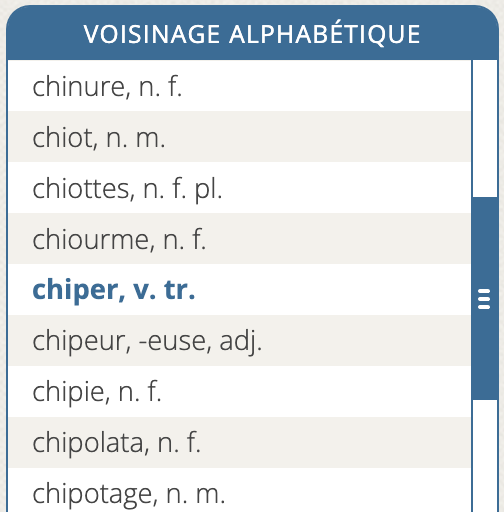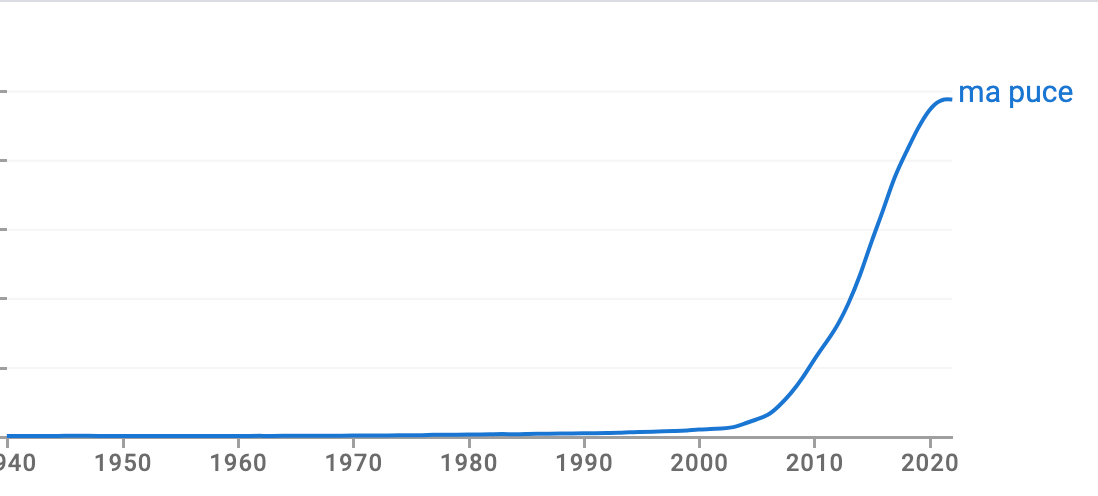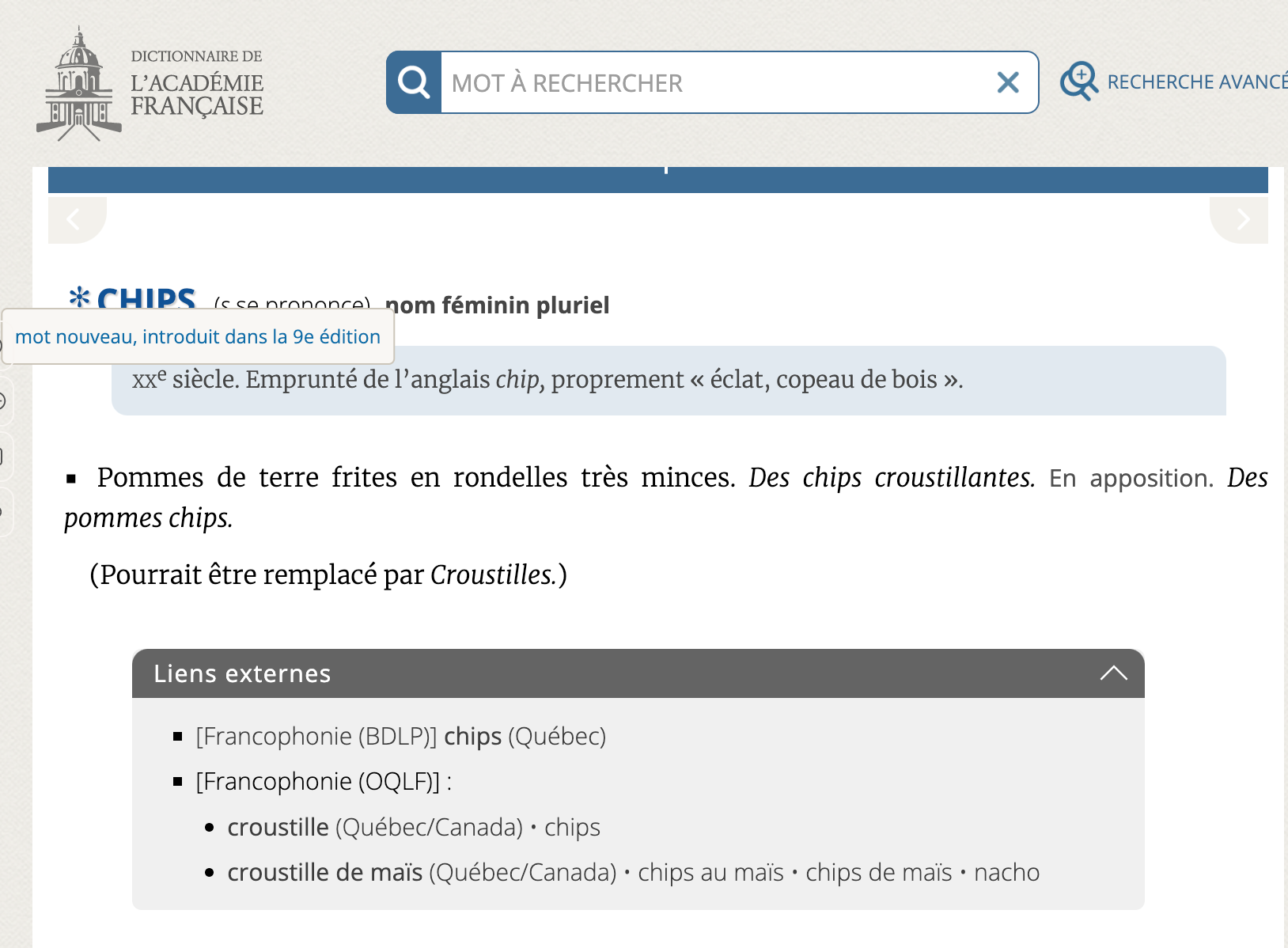Chips, fleas, lovers, colors, and crusts
Language Log 2024-11-13
La 9e édition du Dictionnaire de l’Académie française:
La 9e édition du Dictionnaire de l’Académie française, dont la publication a commencé dans les années 1980, s’est achevée en novembre 2024, avec la parution du tome 4 aux éditions Fayard.
The 9th edition of the Dictionary of the French Academy, whose publication began in the 1980s, was completed in November 2024, with the publication of volume 4 by éditions Fayard.
Le Dictionnaire de l’Académie française est l’un des plus anciens dictionnaires de la langue française, dont la première édition date de 1694 et a été suivie de sept autres datant respectivement de 1718, 1740, 1762, 1798, 1835, 1878 et 1935. La 9e édition, dont les trois premiers tomes sont parus en 1992, 2000 et 2011, est désormais achevée ; elle constitue sans aucun doute la version la plus aboutie du projet académique, auquel elle reste fidèle et dont elle conserve les principes.
The Dictionary of the French Academy is one of the oldest dictionaries of the French language, the first edition of which dates from 1694 and was followed by seven others dating respectively from 1718, 1740, 1762, 1798, 1835, 1878 and 1935 The 9th edition, the first three volumes of which were published in 1992, 2000 and 2011, is now completed; it undoubtedly constitutes the most accomplished version of the academic project, to which it remains faithful and of which it preserves the principles.
One of those principles has been reluctance to acknowledge the validity of borrowed words, especially words borrowed from English. As one tiny test, I took at look at the new dictionary's treatment of the word chip, which tells us something about the Académie's lexicographic sensibility, and even more about variations in semantic drift.
A couple of chip's many senses in English — Wiktionary gives 17 — are in fairly common use in French, because their referents originated in Anglophone countries: those referring to electronic chips and potato chips.
The 9th edition has no entry for the singular form chip: 
In the electronics sense, the native word is puce, as a metaphorical extension of the word for "flea".
I'm curious about the history of that usage, since I doubt that it would never have occurred to an Anglophone engineer to call a computer chip a "flea". The borrowed English word can sometimes be found in French, e.g. in the headline "Apple dévoile son puissant chip M4 Max haut de gamme", though the headlined article uses puce throughout. And the English compound chipset seems to be roughly as common as jeu de puces, though of course it's also absent from the 9th edition.
Looking through the entries for puce in various French dictionaries, I learned a couple of other things about cultural differences in flea perception. One is the use of puce as a term of endearment — from the 9th edition entry:
Pour marquer son affection. Ma puce, ma petite puce.
"My little flea"? Puzzling. It's definitely Out There, but the usage seems relatively recent:
And the Wikipedia entry for the color puce offers five quite different values, described variously as "dark red", "moderate red", "deep brown", and "dark grayish reddish brown", also placing puce among "Shades of pink" as well as "Shades of red".
Some history can be found in Clyde Partin, "The Color Puce", Emerging Infectious Diseases 2022:
In pre-revolutionary France, an era of “evocative color nomenclature,” Marie Antoinette’s reign was precipitating intense criticism. Her countrymen were experiencing severe socioeconomic stress, thus her sartorial self-indulgence was much resented.
After discovering the Queen wearing a new gown, her husband, Louis XVI, the King of France, chided her, describing the dress’s unflattering purple‒brown hue as “couleur de puce” (color of fleas). This admonishment had the unintended consequence of promoting puce as the exclusive color worn by the French court. Puce, the French word for flea, descends from pulex (Latin). Flea droppings leave puce colored “bloodstains” on bedsheets. The role of fleas, however, as a vector for bubonic plague was not proven until about 1895.
Turning our attention to edible chips, the plural form has been added to the 9th edition:
The suggested alternative croustille is of course also (based on) an older borrowing.
Interestingly, the sense offered for chips corresponds to the usage in Australia, Canada, and the U.S. — apparently the British form crisp(s) hasn't been borrowed. At least it's not in this dictionary edition.

